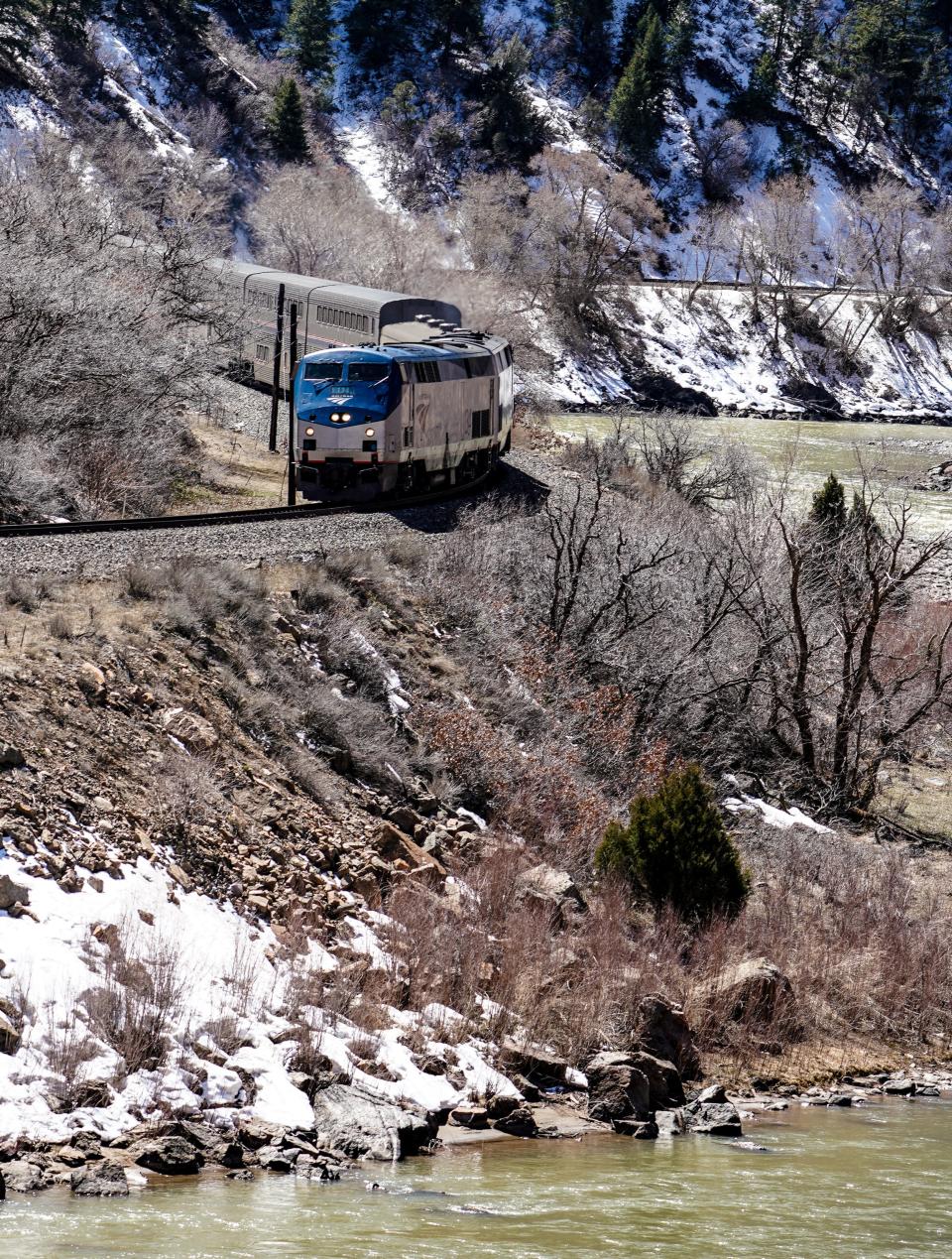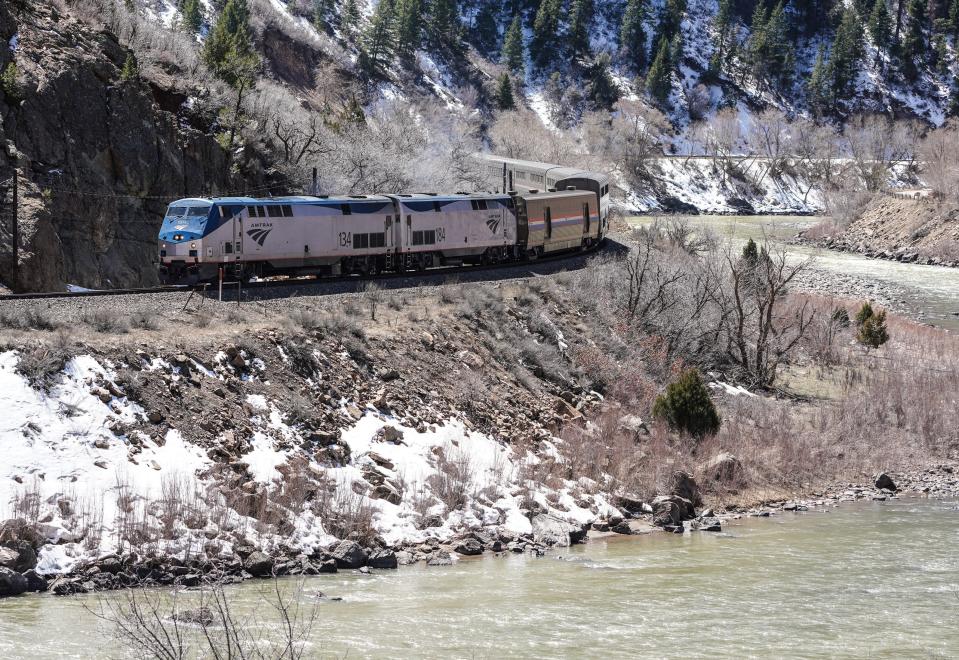Rivers and railroads: When trains derail, water is often nearby. Blame decisions made 150 years ago.
GLENWOOD SPRINGS, Colo. – The kayaker floating down the Colorado River looked up from a peaceful passage downstream as Amtrak's California Zephyr rumbled past.
Rolling on narrow rails supporting a pair of 460,000-pound locomotives and several cars, the train banked around a curve just feet from the water's edge and vanished toward California.
The #5 had already followed the Colorado River for more than 100 miles through the narrow canyons of its headwaters in central Colorado and would follow it for another 100 miles before diverging in eastern Utah to head to Salt Lake City.
Not only Amtrak's passenger trains use the tracks, though – loaded freight trains roll alongside the river that supplies more than 40 million Americans with water across seven states, twice as many as are served by the Mississippi River.

In addition to the Colorado River, train tracks run collectively for thousands of miles along other major waterways, from the White River bordering Vermont and New Hampshire to New York's Hudson River; the Mississippi River in Louisiana; the Columbia River between Washington and Oregon; and portions of the Missouri River.
That's why train derailments tangling with waterways are an predictable problem. In the past decades, it's happened in Alabama, Pennsylvania, Wisconsin, Oregon, Iowa, West Virginia and other states.
Not all of them have led to water contamination or other pollution, but now a series of high-profile train derailments around the country is focusing new attention on this old problem.
Decisions made more than 150 years ago about where to run railroad tracks have significant consequences today when trains derail. And some experts say climate change, which is altering rainfall and flooding patterns, could increase the risk of washouts and mudslides on tracks.
"Railroads are next to rivers everywhere," said former locomotive engineer Fritz Edler, 69, a spokesman for Railroad Workers United, a union group. "And we don't get to distinguish where we have a derailment."
DATABASE: Hundreds of trains derail every year. Search our database to see how much damage they do.
BACKGROUND: Trains keep derailing all over the country. What's going on?

Why are so many railroads next to rivers?
In the rush to build railroads across America, construction engineers often followed rivers, which people had historically used to travel.
River ports were where cities initially grew, and European settlers spread out from there, following waterways like the Mississippi and Missouri rivers. Further west, rivers like the Colorado helpfully carved paths through the Rockies that railroad workers exploited to lay track.
That's why so many of the recent derailments have featured train cars spilling into or near waterways: That's where the tracks run.
"And the fact of the matter is that many interstate highways go along the same routes, for the exact same reason – you're seeking the path of least geographic resistance," said Paul Hammond, a train historian and executive director of the Colorado Railroad Museum.
Hammond said train tracks across the country were often built by competing private companies racing to develop the first connections. That meant dueling railroads sometimes started building track alongside both sides of a river, or raced each other up nearby river canyons to cross mountain ranges. Once completed, railroads upended existing models of trade, allowing people and perishable goods to cross the growing United States in days instead of months.
Union workers at railroads have been warning of increased accident risks for more than a decade, but have dramatically ramped up their public comments following a series of derailments from Ohio to Minnesota to Pennsylvania.
The most recent major derailment spilled cases of beer into a Montana river. The East Palestine, Ohio, derailment contaminated several creeks along the rails and prompted authorities to monitor drinking water withdrawals from the Ohio River.

Today's trains are much different than when these railroads were built
Federal statistics show trains nationally derail three times a day on average, with most of those derailments happening at low speed in rail yards, resulting in little damage or environmental concern. But railroads have shed 40,000 workers in the past four years while moving roughly the same amount of freight, and union officials predict we're reaching a tipping point where cutbacks inevitably lead to more and worse crashes.
"These rail grades I travel were built in the 1860s. We go through tunnels that were built in 1911. It's super steep and you have to be really engaged when you're running that train," said engineer Danny Brewer, speaking trackside from Wyoming. "It takes a lot of attention and professionalism."
PHOTOS: Montana freight train derailment dumps cases of Coors Light and Blue Moon beer
VIDEO: Train derails in rural North Dakota and spills chemical
Freight railroads say heavy investments in technology and better rails have dramatically reduced the number of derailments nationally. According to federal records, trains derailed 1,164 times last year, and 1,095 times in 2021. But in 1979 railroads reported 7,482 derailments, and reported 6,442 in 1980.
Union officials like Edler and Brewer say they believe trains remain a safe and effective way to transport freight long distances. But they worry freight rail companies have cut staffing so deeply that more derailments are inevitable due to equipment failures and the increasing length and weight of trains.
Today, 200-car trains are common, while the average length in 1929 was just 48 cars, according to federal officials. Train cars vary in length, but many freight trains in the west stretch two miles long, and experts say those longer trains are heavier and harder to control on hills with curves – exactly the same kind of scenario alongside the Colorado River.
Water pollution has happened — will happen again
In 2004, a 105-car-long Union Pacific coal train climbing up Glenwood Canyon derailed, spilling at least five carloads of coal into the Colorado River.
It's derailments like that which have some Colorado lawmakers concerned about plans to build a new railroad across northern Utah to carry crude oil extracted from the Uinta Basin. That 85-mile-long rail line would connect to the Union Pacific tracks, allowing five two-mile-long trains a day carrying billions of gallons of crude to rumble along the Colorado River on their way to Gulf Coast oil refineries.
BACKGROUND: After East Palestine, Ohio, derailment disaster, Utah oil train plan under new scrutiny
DATA: Hundreds of trains derail every year. Search our database to see how much damage they do.
The line is backed by Utah state and tribal officials, but opposed by many environmental groups who fear the waxy oil could contaminate the Colorado River. Federal officials predict that an accident involving a loaded Uinta oil train would occur approximately once every 3 to 10 years, and that 25% of those accidents would result in an oil spill.
Federal officials also noted that trucks are far more likely to crash and leak than a train, although critics point out that a single truck crash is minor compared to a potentially catastrophic train derailment.
U.S. Sen. Michael Bennet, a Colorado Democrat, is pushing the Biden administration to block the Uinta railroad. He said the best solution is to just leave the Uinta crude oil in the ground, not build a new rail line, and definitely not run oil trains alongside the Colorado River, even though that's pretty much the only route possible.
"There's only river – only one Colorado River, one Colorado River that serves 40 million people," he said. "This train has no business bringing oil from Utah through Colorado. Period. Period."
This article originally appeared on USA TODAY: Train derailments and rivers: An old, predictable, dangerous problem

